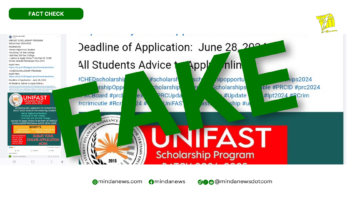PANABO CITY (MindaNews/03 June) – “To contribute to national food security; ensure rational and judicious development; sustainability and conservation of the country’s fisheries resources including the EFZ and adjacent territorial waters; reduce poverty incidence in the coastal areas; and enhance fisheries folk empowerment.”
Holding in my hands the latest publication of the Bureau of Fisheries and Aquatic Resources – Regional Fisheries Training Center (BFAR-RFTC) and reading the goals of their ongoing project called Marine Fish Cage Livelihood Project of Fisher folk Families, I thought to myself: “How ambitious!”
However, a morning of visiting the Mariculture Park in Panabo City has opened my eyes to their capability of fulfilling their ambition.
We were lucky to visit the Mariculture Zone just as one of the fisherfolk families was harvesting bangus, the second time since they started to receive support from the project last year. Seeing the happiness spread around when they were collecting, sorting and packaging the newly harvested bangus for sale, I had the feeling that whatever the project is being run on, it is going on the right direction.
Livelihood improvement
Panabo City Mariculture Zone/Park has an area of 1,075 hectares covering three coastal barangays: JP Laurel, Cagangohan and San Pedro. The marine fish cage area is 60 hectares.
The mariculture zone is designed to produce different targets for sea cage culture, such as bangus, siganid, grouper, red snappers and seaweed farming, mussel culture, pearl oyster culture and sea ranching of lobsters.
This is a partnership project among BFAR-RFTC and Regional Fisheries Office Davao City, Provincial Fishery Office Davao de Norte and Landbank of the Philippines Davao.
According to the information provided by Dr. Andrew M. Ventura, Training Center Director, BFAR-RFTC here, 300 fish cages owned by local investors have been established in the Mariculture Park since 2006, 20 of them operated by fisherfolk families.
These are funded by BFAR and LBP. The counterpart from BFAR is the cage structure and fingerlings. They are also in charge of training and technical support for the operators. They will ensure the fisher folk with a regular market and steady price of bangus. The counterpart of LBP is microfinance and supply of feeds to the marine fish cages of the operators as loans; about 400-600 bags/ per cage. PhP 290,000 at 400 bags and PhP390,000 at 600 bags with a loan interest of 1.76% per month.
Dr. Ventura emphasized that all of the fisherfolk families are able to pay 100% of their loans.
The production has been going well and they have also been able to generate additional incomes of from 10,000 to 20,000 pesos per family per month.
The fish should be fed to grow from juvenile of 50 grams to a fully grown fish of 500 grams after four months. A fish cage of 10,000 pieces of fingerlings is expected to produce approximately four to five tons of bangus. One with 15,000 pieces of fingerlings can produce up to 6.5 tons of bangus.
Every 15 days, the bangus are weighed to determine the amount of feeds given to every fisherfolk family.
The project has created 514 jobs for fisherfolk living in coastal barangays covered by the mariculture park.
Getting on a small boat, we headed to one of the fish cages of a fisher folk family, Teofilo Verallo.
His family started to receive financial and technical support from Marine Fish Cage Livelihood Project of Fisher folk Families from 2011 and had his first harvest in September the same year. The first harvest took them by surprise — 6.6 tons of bangus which earned them PhP 97,000 net income.
This June, they will have their second harvest.
Verallo used to be a mere harvester for other fisherfolk family until he and his siblings started their own fish cage. They have since been taking care of the fish cage on rotation every day.
Environmental concerns
There is no doubt about the success of the livelihood aspect of the project. But environmental concerns have been raised, that the concentration of many fish cages in one area can cause pollution to the water.
Helix Anne Abangin, technical assistant of BFAR-RFTC, confirmed that overfeeding can cause pollution. The fish are fed six to seven times a day and the amount of redundant feeds can pollute the sea bottom. But she also assured that before joining the project, the fisherfolk are required to attend trainings on culturing technique and environment protection.
The trainings include ensuring sacks used in storing feeds are reused. Also, they are not allowed to set up comfort rooms in the area of fish cages.
The water quality monitoring is conducted every month by the RFTC to test the oxygen percent and the existence of pesticides in case of chemicals eleased from the plantation to coastal area.
The bangus fish are examined frequently if they are affected by any harmful chemicals. The latest monitoring showed that the quality of the bangus is chemical-free.
Coming from Vietnam, a country with 300,000 kilometers of coastal areas where fishing plays an important role in the economy, I still could not help but be amazed by the achievement of the project.
Well thought through and practical are two main characteristics that echoed in my mind after my visit to the Mariculture Park in Panabo City.
I am glad the fisherfolk have been given the second chance to engage in a livelihood that will assure them a steady income. (Bui Tran Nhu Phuong is a journalist from the Vietnam Forum of Environmental Journalists visiting MindaNews under the Fredskorpset Journalism Exchange
Program.)
